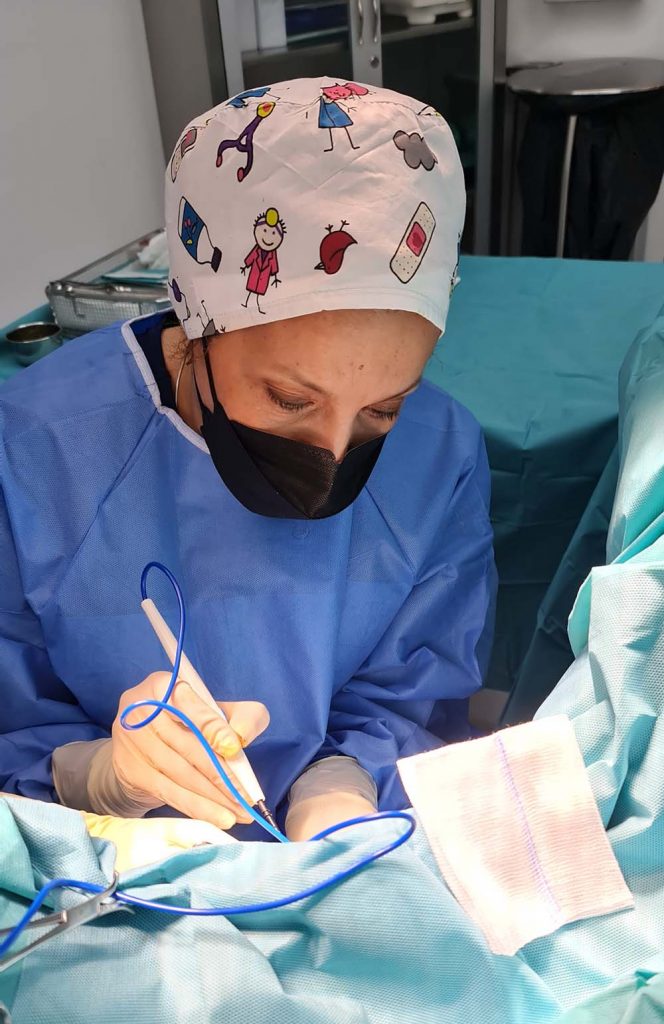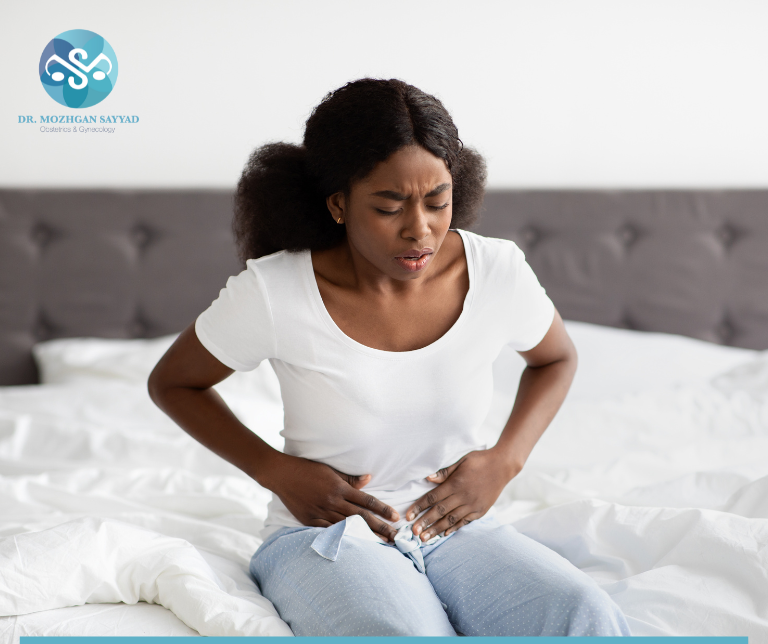
What is Ovarian Cyst?
An ovarian cyst is a sac filled with fluid or semisolid materials that develop on or inside, on one or both ovaries. Ovarian cysts are extremely common, especially for pregnant and premenopausal women. In fact, it’s estimated that ten in 100 women have ovarian cysts.
Often painless and asymptomatic, ovarian cysts rarely require any treatment and go away within a few months.
Types of Ovarian Cysts
Most cysts are functional cysts and develop as a response to menstruation. On the other hand, ovarian cysts forming unrelated to the menstrual cycle are uncommon. The various types of ovarian cysts are:
Functional Cysts
Functional cysts, also known as physiologic ovarian cysts, are the most common form of cysts in women. The ovaries produce small cysts called follicles each month. These follicles create necessary hormones [estrogen and progesterone] and break open to release the egg when ovulating. A monthly follicle that grows each month is known as a functional cyst.
Functional cysts are usually a sign that the ovaries are working well, and therefore, they’re perfectly normal and harmless. They rarely cause any discomfort and disappear on their own after two to three menstrual cycles. There’re two types of functional cysts, they’re:
- Follicular Cyst: As mentioned earlier, the follicle releases an egg each month. If the follicle doesn’t rupture and doesn’t release an egg, it will continue to grow and develop into a follicular cyst. Follicle cysts don’t cause any symptoms and disappear in one to three months.
- Corpus Luteum Cyst: Corpus luteum cyst is a cyst develops inside the follicle after an egg is released. Once the egg travels down the fallopian tube, the follicle, now known as corpus luteum, is responsible for producing hormones necessary for pregnancy. If conception doesn’t occur, the follicle will shrink and break down. However, in some cases, fluid builds up inside the corpus luteum, resulting in a cyst. Most corpus luteum cysts go away within a few weeks. But they can grow up to four inches wide and cause bleeding or twist the ovary.

Other Cysts
Ovarian cysts that are unrelated to menstrual cycles are:
- Dermoid Cyst: Dermoid cysts, also known as teratomas, form from cells present during birth. This cyst contains tissues like hair, skin, or teeth. Dermoid cysts are rarely cancerous.
- Cystadenoma: Cystadenomas are fluid-filled [watery or mucous material] cysts that develop on the surface of an ovary. A cystadenoma has an average size of 10 cm, and in rare cases, it can exceed 30 cm.
- Endometrioma: Endometriomas are caused by endometriosis. Endometriosis is a condition where the cells inside the uterus develop outside the uterus. Some tissues can attach to the ovary and form a cyst called endometrioma.
Dermoid cysts and cystadenomas can grow largely and even shift the ovary out of its position. This can increase the chances of ovary torsion, a painful twisting of the ovary.
Causes of Ovarian Cysts
Ovulation is the primary cause of ovarian cysts. Other causes include:
- Hormonal Issues: In some cases, cysts develop due to hormonal imbalance or by drugs that enable ovulation.
- Endometriosis: As aforementioned, women with endometriosis can develop an ovarian cyst called endometrioma. These cysts can cause pain during intercourse and period.
- Abnormal Cell Reproduction: Abnormal cell reproduction can result in cysts like dermoid and cystadenoma.
- Pregnancy: An ovarian cyst can also develop during early pregnancy to support the pregnancy until the placenta forms. In some cases, the cysts stay until further in pregnancy and may need to be removed.
- Severe Pelvic Infection: Severe pelvic infection can spread across the ovaries and fallopian tubes and cause cysts to develop.
Symptoms
Most cysts don’t cause symptoms and resolve on their own within a few months. However, a large ovarian cyst can cause:
- Pelvic pain varies from dull, heavy ache to sharp pain below your bellybutton on one side
- Fullness or pressure in the abdomen
- Bloating
- Breast tenderness
- Nausea and vomiting
- Pain during intercourse
- Difficulty emptying bowels
- Frequent urination
- Variation in period [heavy, irregular, or lighter cycles than usual]
- Feeling full after eating little
- Difficulty conceiving
Risks or Complications of Ovarian Cysts
Although rare, the complications of ovarian cysts include:
- Ovarian Torsion: Cysts that become larger in size can distort the placement of the ovary and cause it to move. If this happens, it can lead to a painful ovary twisting, also known as ovary torsion. Ovary torsion causes severe pain, nausea, and vomiting. It can also reduce or stop blood flow to the ovary, causing it to die.
- Cyst Rupture: A cyst can burst open and cause extreme pain and bleeding inside the pelvis. The larger the cyst, the greater likelihood of rupture. Vigorous activity that affects the pelvis, like vaginal sex, can also increase the risk of rupture.
- Infected Ovarian Cyst: Certain pelvic infections can lead to cyst development, forming an abscess. If the abscess bursts, harmful bacteria can spread across the body.
- Cancerous Cyst: Cysts that develop after menopause have greater chances of being cancerous.
Diagnosis
An ovarian cyst can be detected with a pelvic examination or an imaging test. Depending upon its size and what it’s filled with, the healthcare professional will recommend the appropriate test and treatment. Possible tests to diagnose ovarian cysts include:
- Pelvic Exam: The doctor may conduct a pelvic exam to check for lumps or changes inside the pelvis.
- Pregnancy Test: A positive pregnancy test may indicate that the patient has a corpus luteum cyst.
- Blood Test: If the woman is in her menopause, the doctor may request a blood test to measure the amount of cancer-antigen 125 [CA-125] in her blood. If a woman has ovarian cancer, the amount of CA-125 is high. However, in premenopausal women, several other illnesses can cause higher levels of CA-125.
- Hormone Levels Test: The doctor may recommend a hormone level test to evaluate if there’s any hormonal imbalance.
- Pelvic Ultrasound: A pelvic ultrasound incorporates high-frequency sound waves to develop images of the uterus and ovaries. The doctor can identify the shape, size, location, and mass [whether it’s fluid, semisolid, or solid] with an ultrasound.
- Laparoscopy: Performed in an operating room and under anesthesia, the doctor inserts a slim and lighted instrument, a laparoscope, into the abdomen. If cysts are found, it’s usually treated during the same procedure.
Treatment
In most cases, ovarian cysts are non-cancerous [benign] and resolve on their own in a span of a few months. With that being said, if the cysts are large or cancerous, treatment is required. The treatment largely depends on vital factors like age, symptoms, and the underlying cause of the cyst. Some of the treatment includes:
- Watchful Waiting: Functional cysts often go away without any intervention. If the cysts are likely functional, the doctor may wait and reexamine after a few weeks or months. Regardless of age, this is typically an option if the cysts are small and fluid-filled. The patient may also have frequent ultrasounds to evaluate the cyst for changes in size or appearance.
- Cyst Medications: The doctor may also prescribe medications containing hormones like birth control pills to block ovulation and prevent further cysts from developing.
- Surgery: If the cyst causes symptoms and gets bigger, the doctor may suggest surgery to remove it completely. The type of surgery depends upon the size of the cyst and how it appears on the ultrasound. Ovarian cyst surgeries include:
1. Cystectomy: A medical procedure where the cysts are removed without removing the ovaries.
2. Oophorectomy: A medical procedure where cysts and ovaries are removed.
3. Laparoscopy: A medical procedure that removes cysts through small incisions in the abdomen.
4. Laparotomy: An open abdominal surgery to remove cysts.

Prevention
Usually, ovarian cysts are harmless enough that prevention isn’t a concern. If a woman has recurring cysts, the doctor may recommend medications containing hormones to stop ovulation. Instead of prevention, take note of symptoms that may signal a cyst and inform a healthcare professional. Regular pelvic exams can also detect cysts early on.
When to Seek Medical Attention
Seek medical attention if the following symptoms appear:
- Sudden, sharp abdominal or pelvic pain
- Pain accompanied by fever or vomiting
- Signs of shock include rapid breathing, cold and clammy skin, and dizziness
Get Help with Dr. Mozhgan
In conclusion, ovarian cysts are normal, harmless, and resolve independently. However, it’s essential to understand its symptoms to seek proper treatment and medical attention.
If you’re in Dubai and looking for ovarian cyst treatment, book an appointment with Dr. Mozhgan, a highly skilled and experienced female gynecologist based in Dubai. With her vast knowledge and limitless compassion, you can trust that you will receive the best solution for your ovarian cysts.
Don’t hesitate; take control of your health today!
Common Questions, Answered by Expert
Q1. Who is at risk of getting ovarian cysts?
Anyone can develop ovarian cysts; the chances increase based on the following:
- Age: Ovarian cysts are common during the premenopausal stage.
- Pregnancy Status: Pregnant women are more likely to develop cysts.
- History of Cysts: The likelihood of developing cysts increases if someone has a history of ovarian cysts.
- Current Medical Conditions: Women affected by endometriosis, hormone problems, or under medications to aid ovulation are more at risk of developing cysts.
Q2. Can ovarian cysts make it harder to get pregnant?
Typically, most ovarian cysts don’t affect pregnancy. However, the underlying condition that causes cysts can make it harder to conceive. Two conditions that affect fertility and cause ovarian cysts are endometriosis and polycystic ovary syndrome [PCOS].
Q3. Can ovarian cysts lead to cancer?
In most cases, cysts are not cancerous. In fact, less than 1% of ovarian cysts are cancerous. The risk of getting ovarian cancer increases with age. Women past menopause with ovarian cysts are at higher risk for ovarian cancer.


